When you think of a Bordeaux winery, what images come to mind? If you’ve visited or seen photos, you’re likely conjuring up visions of beautiful châteaux, meticulous vineyards, state-of-the-art facilities, and ornate barrel cellars. Tucked away on Bordeaux’s right bank, however, in the southeast corner of Saint-Émilion, is an unassuming 18th century farmhouse – with peculiar looking vines, dirt on the cellar floor, and no shiny equipment – making wines that rank among the region’s finest.
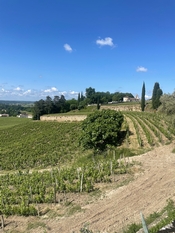
Welcome to the home of Tertre Roteboeuf and its unorthodox winemaker, François Mitjavile.
Born neither in Bordeaux nor to a winemaking family, Mitjavile began his career managing his family’s long-haul trucking business. His in-laws owned Château Tertre, a small estate in Saint-Émilion, which his wife inherited upon her father’s passing in 1961. With no winemaking experience of her own, for many years she leased the vineyards to cousins who owned a winery nearby. Meanwhile, François was finding the monotony of corporate life unfulfilling and was ready to try his hand at winemaking. After the couple relocated to Saint-Émilion in the mid 1970s, François spent two years learning the ropes at Château Figeac before producing his first solo vintage at the family estate in 1978.
With the release of his inaugural vintage, Mitjavile changed the estate’s name from Château Tertre to Château Tertre Roteboeuf, which loosely translates as “hill of the belching beef.” Curious about the origins of the name, I asked François Mitjavile’s son Henri about it on a recent visit to the winery. Henri explained that the name refers to the cattle that used to plough the land and the noises they would make climbing the steep slope where Tertre Roteboeuf stands today. Despite the common misconception, the name does not bear any relation to roast beef (
rôte boeuf) and derives from the French verb
roter (to burp) rather than
rôtir (to roast).
Part philosopher, part poet, and part risk-taker, Mitjavile’s approach to viticulture and winemaking defies many of Bordeaux’s conventional practices. He trains his vines to grow peculiarly close to the ground, almost impossibly so, using thick, double-armed cordons in place of the more common Guyot system. This exposes the low-lying grape bunches to a warmer microclimate, enhancing their potential for ripening. Ripeness is somewhat of an obsession for Mitjavile, who passionately believes it is impossible to achieve an authentic expression of terroir without fully ripe grapes. Notorious for not harvesting until very late in the season, he waits until his grapes have reached a state of what he calls “sumptuous degradation,” that last gasp of freshness before the fruit becomes overripe. Located on a south-facing amphitheater, the vineyard’s naturally cool limestone and clay soils provide the ideal
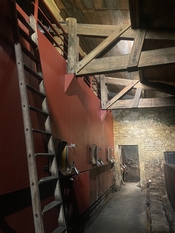
terroir for the slow and steady ripening Mitjavile desires, enabling the grapes to reach an advanced stage of maturity without losing their vibrancy.
Winemaking at Tertre Roteboeuf is not for the faint of heart. Alcoholic fermentation takes place in large concrete vats, at anxiety-inducingly high temperatures. The aging regimen is conventional by Bordeaux standards – 18 to 22 months in 100% new oak barrels, made by the Radoux cooperage with a special wood grain and toast developed especially for the winery – but differs in one crucial aspect: there’s no air conditioning in the cellar. In the winter, radiators keep the temperature above 61° F, and the cellar naturally warms up to around 68° F in the summer. Mitjavile contends that aging the barrels at higher temperatures encourages better and earlier integration between the new oak and the wine. He’s also a strong believer in exposing the wine to oxygen during barrel aging, which he argues both “civilizes” the wine and promotes aromatic complexity in the finished product.
Another hallmark of Mitjavile’s winemaking philosophy is to craft wines that unapologetically express the unique character of each individual vintage. Many Bordeaux producers will blend across plots or designate lower quality fruit for a second wine instead of their Grand Vin to maintain a consistent house style, but
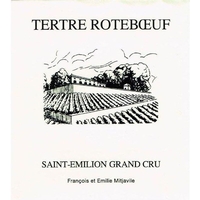
Tertre Roteboeuf sticks to producing just one wine each year, using grapes harvested from the entire vineyard rather than just the best parcels.
Stylistically, the wines marry power with opulence, showcasing luscious fruit and plush tannins, with an elegance and aromatic intensity more commonly ascribed to Burgundy than Bordeaux. Enjoyable in their youth, the wines can also age comfortably in the cellar for decades and develop the savory tertiary notes (think truffle, leather, and smoky tobacco) characteristic of mature Bordeaux. From their 14-acre vineyard, 80% of which is planted to Merlot and 20% to Cabernet Franc, the estate produces about 2,000 cases annually.
Tertre Roteboeuf reserves its grandeur for the wine, not the winery. A simple stone marker, etched with red lettering, signposts the entrance to the property. The family-run estate has no presence on social media, just a website whose lone page includes a
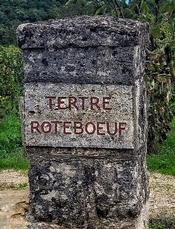
picture of the farmhouse and an email address. Modest as always, Mitjavile dropped the word Château from the winery’s name in 1994. While it has become fashionable in recent years for Saint-Émilion’s top estates to drop out of the region’s classification system, Tertre Roteboeuf never aspired to join in the first place (although it would easily attain Premier Grand Cru Classé status if it ever wanted to apply). Prioritizing long-standing relationships with their early customers, the estate also bypasses Bordeaux’s traditional system of selling
en primeur to négociants in favor of direct sales to merchants and importers. In a similar show of loyalty, the estate has partnered with the same cooperage, cork supplier, and label maker throughout its entire 40+ year existence.
Besides Tertre Roteboeuf, Mitjavile and his children own two other Bordeaux wineries: Roc de Cambes in Côtes de Bourg, and L'Aurage in Castillon Côtes de
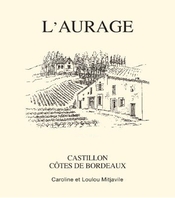
Bordeaux. In the late 1980s, Mitjavile wanted to expand his vineyards, but he could not afford to purchase additional land in Saint-Émilion. Instead, he bought a 35-acre property in Bourg, 45 minutes northwest, with limestone and clay soils and a natural amphitheater reminiscent of Tertre Roteboeuf’s. Today, Nina Mitjavile, François’s daughter, manages the operations at Roc de Cambes. The property also encompasses a separate vineyard at the bottom of the slope, near the banks of the Dordogne River, outside the appellation boundaries of the Côtes de Bourg. The estate separately bottles the wines from this vineyard as Domaine de Cambes and labels them under the generic Bordeaux appellation.
Having learned winemaking from his father, François’s son Louis (known as LouLou) and his wife Caroline purchased L’Aurage in the early 2000s. The nearly 50-acre estate is located just east of Saint-Émilion, in the hills of Castillon, on the same desirable limestone and clay soils. L’Aurage and Roc de Cambes embody the same passionate commitment to terroir expression and meticulous attention to detail as Tertre Roteboeuf. Both properties also adhere to many of the same viticulture and winemaking traditions, including training the vines close to the ground, harvesting only when fully ripe, and aging only in oak barrels made by the Radoux cooperage.
Tertre Roteboeuf is a world away from mainstream Bordeaux in many respects, but unfortunately cost is not one of them. Although less expensive than the Grand Vins of neighboring Saint-Émilion châteaux like Angelus, Figeac, and Pavie – and a comparative bargain relative to Ausone and Cheval Blanc – older vintages of Tertre Roteboeuf are highly sought-after in the market and buyers snap up new vintages immediately upon release. Roc de Cambes and L’Aurage have higher production volumes and more moderate prices, yet both are near the top end of the price range for their respective appellations. Prices listed below are from Wine-Searcher.com.
2010 Tertre Roteboeuf ($259): 2010 was a stellar vintage in Bordeaux and an excellent one for Tertre Roteboeuf. Before your nose even reaches the glass, you’re met with a seductive mix of blackberries, kirsch, clove, violet, balsamic, truffle, mocha, sweet tobacco, and smoky cedar. Rich and voluptuous on the palate, the wine has a silky texture, ripe velvety tannins, and a freshness that balances and masks any perception of the high alcohol (listed at 15.5%). Waves of dried berries, hickory, and truffle linger throughout the massive savory and sweet finish. It’s drinking beautifully now but has at least another decade of aging potential.
99
2020 Tertre Roteboeuf ($219): The gorgeous nose opens with fragrant black cherry, plum, damp earth, cedar, and smoky tobacco aromas. Lush and decadent, the wine’s fresh acidity balances its youthful intensity and dense concentration, and fine-grained tannins and seamlessly integrated oak provide ample structure. The palate brims with juicy blackberries, cassis, dark chocolate, and truffles, all of which flicker and dart throughout the sublimely persistent finish. This vintage would benefit from another year or two in bottle before drinking and will cellar well for another two decades.
97
2020 Roc de Cambes ($62): Intensely perfumed aromas of ripe plum, blackberry,
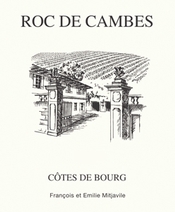
espresso, dried tobacco, and bacon fat. A mix of sweet and savory flavors explode on the palate, mingling spicy black fruit with mocha, leather, and a salty dash of beef jerky. Ripe powdery tannins provide structure to the rich and opulent midpalate and the wine finishes long and dry with hints of chocolate and charred wood. Drink now or keep in the cellar for the next 10 to 15 years.
94